FAQ : Intruder Detection Sensors and Systems
Photoelectric Detectors
- What is Sunshine Protection Technology?
-
The sunshine protection technology has a triple layer construction to give better performance against external light sources (e.g.:the sun, mercury-vapor lamps, and fluorescent lights).

- What is Double Modulation Beam?
-
The SL-QDM and SL-QDP offer double modulation beams that differ in pulse patterns. This can enhance signal discrimination against potential noise interference such as sunlight or other external light sources, resulting in a reduction of missed alarms. Together with OPTEX triple layered sunshine protection technology, it ensures high reliability under the severe outdoor security environment.

- What is A.T.P.C.(Automatic Transmit Power Control)?
-
Automatically controls, adjusts and optimizes the power of the beam and maintains optimal performance. It decreases false and missed alarms caused by fog, frost, cross talk, signal saturation.
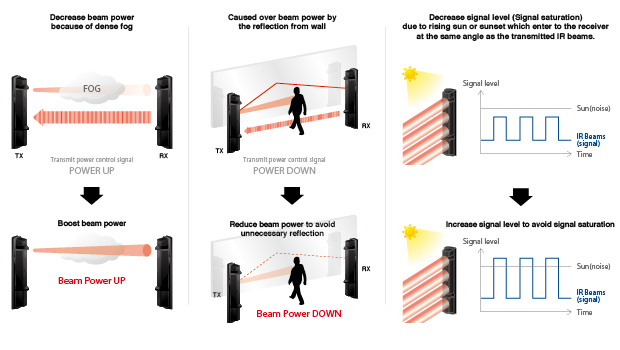
- What is Quad Beam & United Aappearance?
-
By employing quad beam, it dramatically reduces false alarm caused by birds and falling leaves. Moreover, it is also important that the housing design of both long and short beams are united. 60m (200ft.) range models, SL-200QN/SL-200QDP/SL-200QDM with a wide beam pitch is now available.

- What is Lightning & Surge Protection?
-
Lightning surges are a constant source of problems for electronic equipment that is used outdoors. There are two types of lightning surge: 1) direct strike and 2) induced surge.
In a direct lightning strike, the amount of energy dissipated is so great that there is currently no means of protecting electrical equipment from damage. A lightning induced surge may be caused by the movement of charged clouds or a nearby lightning strike. Either of these causes can induced surge voltages in electrical wiring. It is possible to provide some degree of protection against lightning induced surges by installing surge absorbers at appropriate locations as shown in the diagram.
Our Smartline series and AX series can withstand a lightning surge up to 14kV without damage resulting in faulty operation (IEC801-5 lightning surge noise is the maximum level of our test).
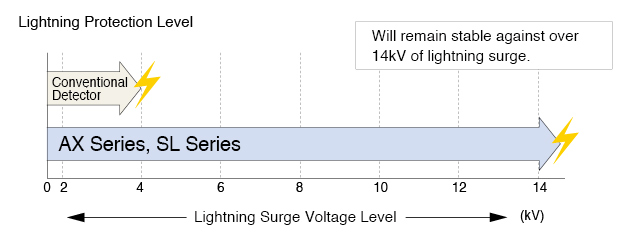
- What is Sniper Viewfinder?
-
The new telescope lens has a high level of visibility for optical alignment work. Even over long distances, a perfect installation and stable performance can be achieved in a short period.
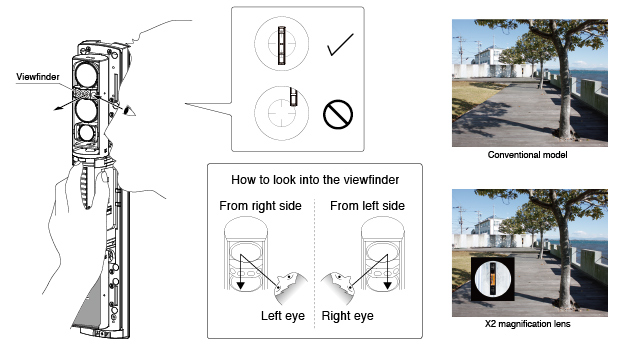
- What is LED Indicator and Sound Assist?
-
The alignment level indicators have 5 LEDs, each LED represents the level of alignment, ranging from poor to excellent. The optical alignment level can also be checked by sound.
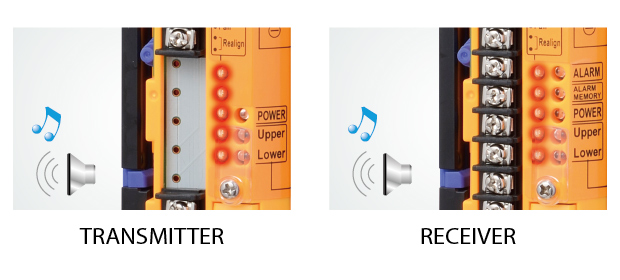
- What is Beam Power Control Selector?
-
The beam power control selector allows you to manually adjust beam power from NORMAL to LOW or VERY LOW. This function is effective for the following purposes:
- For countermeasure against crosstalk due to reflection ofwall or floor by reducing beam power.
- For countermeasure against interference due to unstable S/N (signal / noise) ratio when using multiple photo beams for long distance or beam stacking applications.
- To reduce beam power when using the detector for a distance shorter than the rated distance.
- To search the peak value when making optical alignment to support perfect alignment.
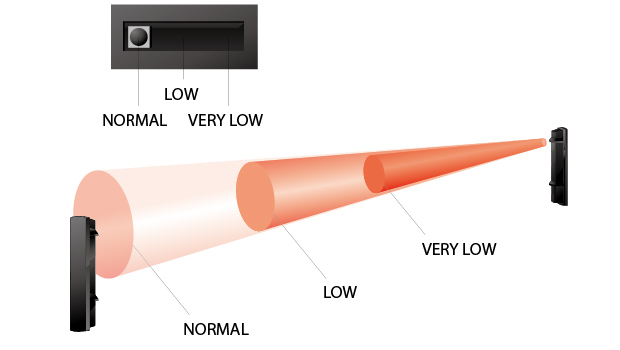
- What is Maximum Arrival Distance, Maximum Detection Range & Sensitivity Tolerance?
-
To search the peak value when making optical alignment to support perfect alignment.
Sensitivity Tolerance
Sensitivity tolerance can be calculated from maximum arrival distance and detection range. Distance tolerance is a distance allowance value against the reduction of the beam by external factor.
Distance tolerance = (Maximum arrival distance/ Detection range)
Sensitivity tolerance = (Distance tolerance)²
e.g) In case of using SL-350QFR at the distance of 100m ( Maximum arrival distance: 1,000 m )
Distance Tolerance =10 times
Sensitivity Tolerance = 100 times
A certain amount of sensitivity tolerance is required for the stable operations of outdoor photoelectric detectors without false alarms, because the beam power is reduced under severe outdoor environments, e.g. dense fog, rain, snow or dust storms. The following figure is the general indications. All Optex outdoor photoelectric detectors have sensitivity tolerance of 100 times at a rating distance.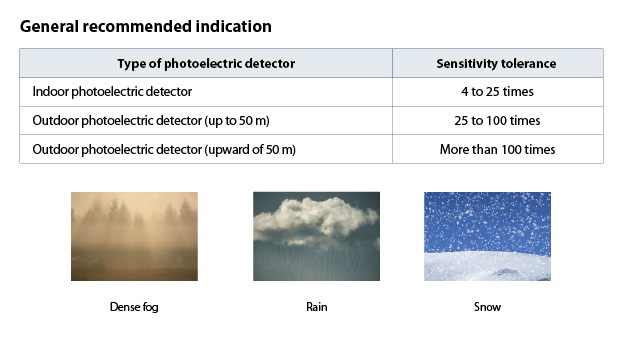
- What is Adjustable Beam Interruption Time?
-
By using the beam interruption time potentiometer, it is possible to increase the time the beam must be broken in order to generate an alarm. This will reduce the chance of false alarms being caused by falling leaves, blowing debris or animal or bird movement within the protected area. Refer to the diagram before making any adjustments. If you make the beam Interruption time too long, quickly moving intruders may be able to pass through the beams undetected. After performing this adjustment be certain to do a walk-thru test and confirm that the detector will provide a satisfactory level of protection.
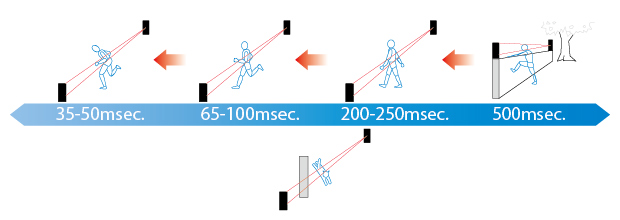
- What is A.G.C. (Automatic Gain Control) circuit?
-
The A.G.C. circuit continually monitors for gradual changes in the signal’s strength caused by changing weather conditions. It gains the sensitivity accordingly to maintain weather conditions.
- What is D.Q. output(environmental disqualification)?
-
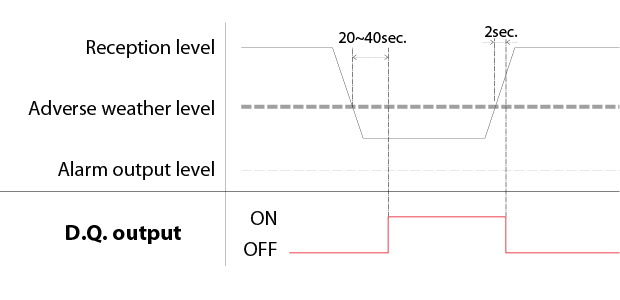
- How do the Back box for wireless transmitters and batteries work?
-
Back box can conceal wireless transmitter. Especially, AX-100/200TFR allows you to easily replace the batteries without opening the front cover. Not necessary to do the optical alignment.
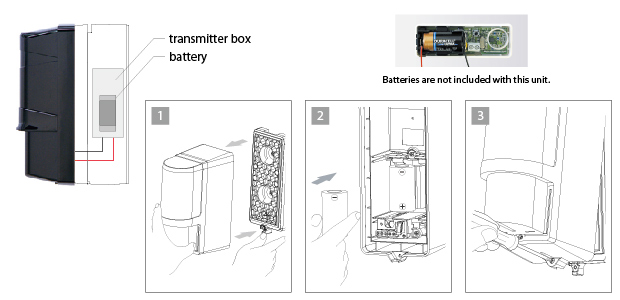
- What is Intermittent output function?
-
Alarm signals are sent periodically to avoid missed alarm while the beam is broken. Its function is effective for wireless systems which do not recognize "Restore" status.
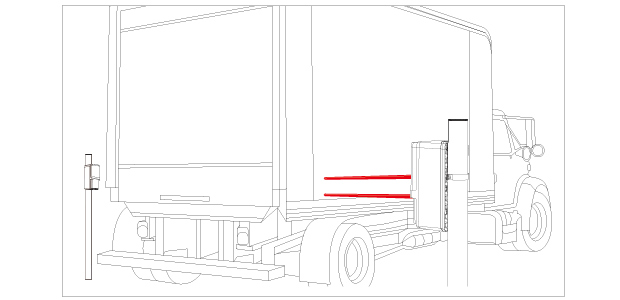
- What is Battery saving timer function?
-
Alarm output activation are limited by a timer to 5 to 120 seconds. Even if there are continuous alarm events, the alarm output operates only once in the timer period. It prolongs the battery life of a wireless transmitter.
- What is Low Battery Output and LED?
-
When the battery capacity becomes low, the unit automatically outputs fixed time transmission to call attention. When low battery signal is output, Anti-masking function will be canceled in order to extend the battery life. When low battery signals is output, replace all the batteries with new ones.
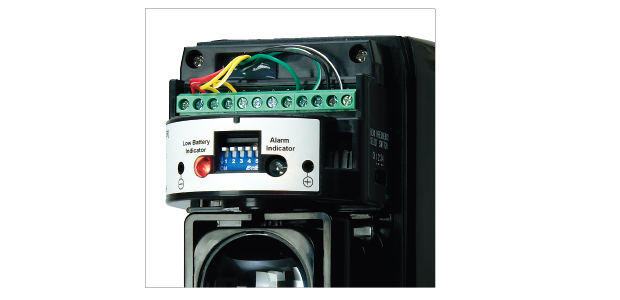
PIR and Microwave detectors
- What is Advanced Temperature Compensation?
-
At a higher ambient temperature, the temperature difference between the background and a human body will be reduced. In this case the PIR could fail to readily detect a human body. With conventional temperature compensation functions, the sensitivity of detector must be set higher at 35°C than the sensitivity at 25°C (normal temperature) in order for the detector to offer a stable performance. However, with this setting, the sensitivity of the detector is excessively high at 40°C or over, which could lead to various problems. To overcome this drawback, Optex's advanced temperature compensation function allows the detector's sensitivity to automatically drop at 40°C or higher so that the detector can perform more reliably within a wider ambient temperature range.
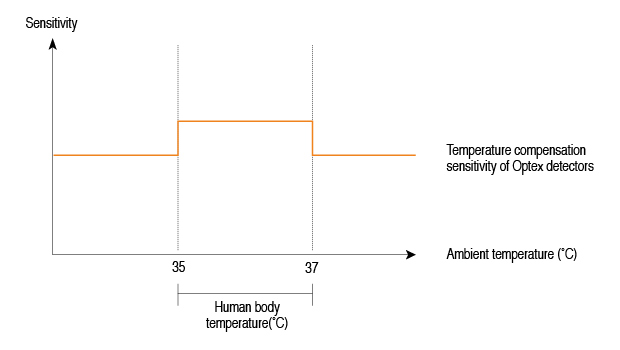
- What is Summer Night Compensation Logic?
-
During summer evenings and nights, areas which are in shade can create an environment where the difference between human body and the surrounding ambient temperature can be at its lowest point. This logic addresses this issue by measuring the luminance levels and the changes in the environment.
The integration of temperature and additional luminance analysis provides the product the ability to more accurately assess true environmental conditions and sharpens the sensitivity as the environmental conditions require.
This combination greatly reduces the potential for missed alarms, while maintaining stability.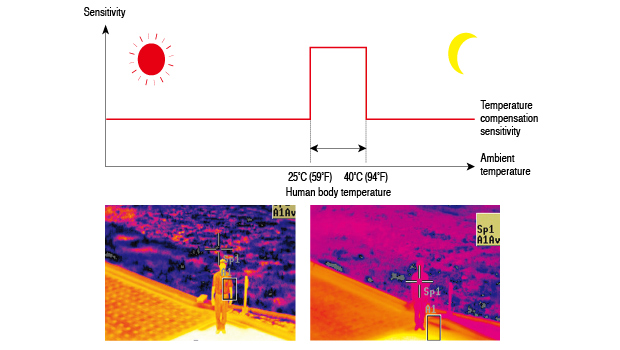
- What is Double-layered Detection Patterns?
-
OPTEX’s outdoor PIR detectors utilize the multiple detection pattern technology, two double-layered detection patterns (upper and lower) both have to be activated to generate an alarm condition. This reduces false alarms, particularly those caused by temperature changes, light reflection and small animals.
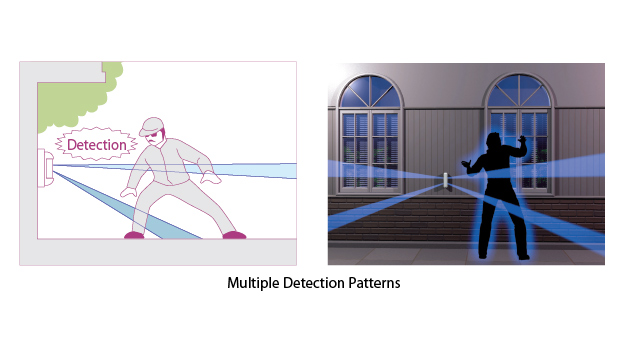
Size Judging Function
The size judging function The size judging function virtually eliminates false alarms due to small animals and other moving objects like car.
- What is Intelligent AND detection Logic?
-
By utilizing originally developed pyro-elements, it creates a configuration area consisting of 94 high density detection zones. Also the AND detection pattern technology requires both detection areas have to be activated in order to generate an alarm condition making it more tolerant to false alarms caused by small animals or pets.
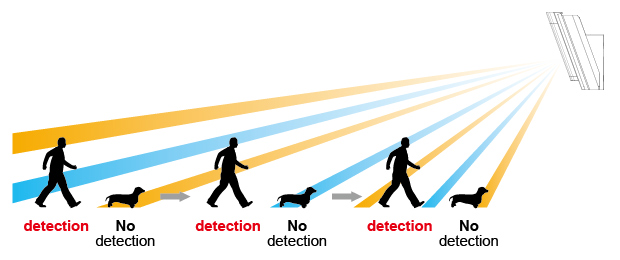
- What are Digital Quad Zone Logic & Multi-Focus Optics?
-
OPTEX has 2 different detection logics, digital quad zone logic and multi-focus optics. Each logic creates high vertical density detection zones by original optical technology to prevent false alarms.
Normally, a detector uses twin elements create two detection zones but Optex’s detectors create an extremely high vertical zone density, two or three times the size of that in conventional PIRs. These taller zones capture the entire body mass of a person and enable detection of the smallest temperature contrast between them and the background.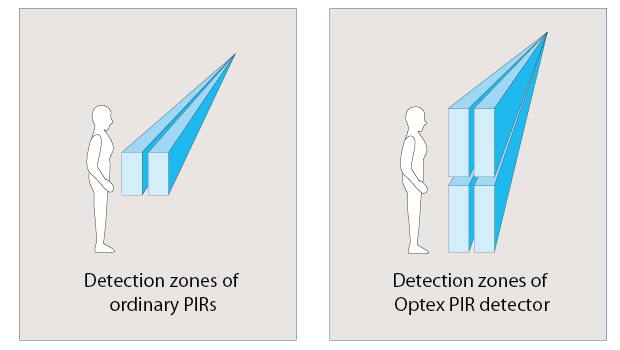
- What is Quad Zone Logic?
-
OPTEX’s indoor detectors have from 78 to 82 zones to cover the hole detection area. At any spot within the detection area more than 4(quad) zones are utilized to verify if it should generate alarm or not. Also the CORE platform enables the quad zone logic to evolve to the next step. Providing digital quantification of infrared energy. digital quad zone logic enhanced accuracy in both human detectability and pet immunity.
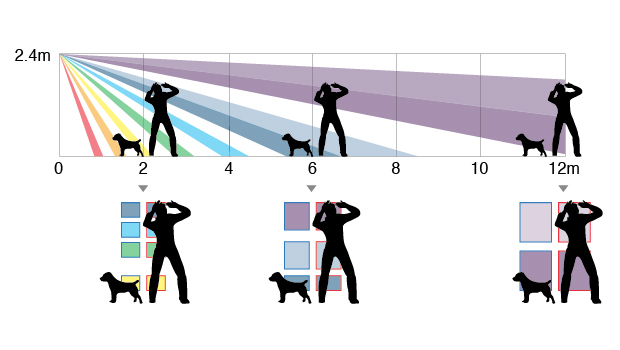
- What is Multi-Focus Optics?
-
If a person is hidden from the PIR detector, he or she is not detected. In ordinary residences and offices, there are desks, shelves and other furniture. When these objects hide a part of the body, it may make detection difficult.
Multi-focus optics provides taller detection areas, which can be raised 1.5 to 2.0 times than ordinary optics and improve the detection ability to eliminate most dead spots regardless of the presence of furniture or other obstacles.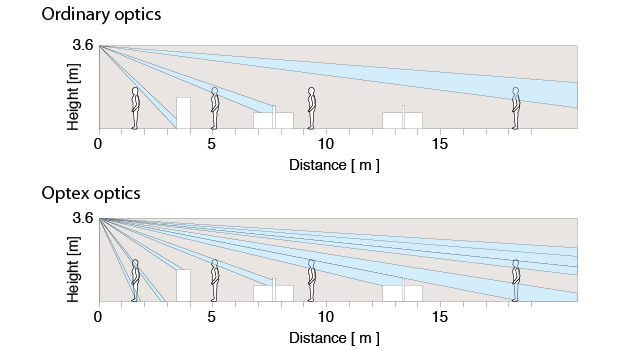
- What is Spherical Fresnel Lens Design?
-
Spherical lens provides a precise focal length to each of the multiple lens segments (uniform distance between each lens segment and the pyroelectric elements). This enables each lens segment to face precisely towards its detection area, and creates detection zones without distortion, achieving a new level in lens design precision.
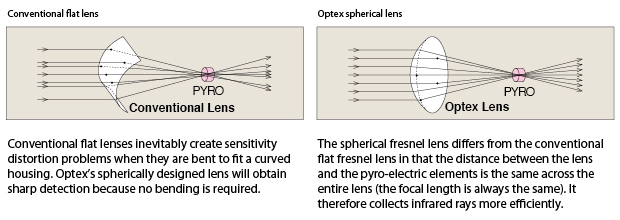
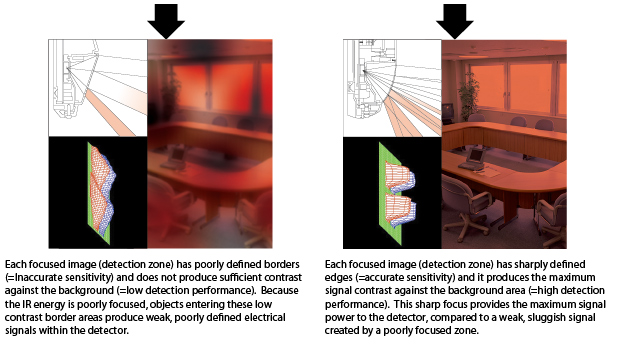
- What is Double Conductive Shielding?
-
By using our patented double conductive shielding, the visible light disturbance and RFI can be blocked.
Visible Light Protection
Visible light disturbance protection will prevent a false alarm when a 60W halogen lamp is turned on close to the detector. No false alarm is triggered even when a car flashes its headlights at the detector at a distance of 30cm (If a car passes through the detector range, of course, the exhaust heat of the car will trigger the alarm).
Also no false alarm will be triggered by sunlight up to an illumination of 100,000 lux. False alarms are most likely caused when early morning or evening sunlight pours into the room, and enters the field of view of the PIR either directly or by reflection. In such a case, however, the illumination reaches only about 50,000 lux. This prevents false alarm, due to double conductive shielding.
RFI Protection
RFI protection has been improved to 20V/m and 30V/m or more by utilizing the double conductive shielding.
A field strength of 20V/m means that even if a 10W transmitter is placed within 1 meter of the detector and interference is produced, it will not cause false alarm. With a field strength of 30V/m, a 10W transmitter can be placed within 30-35cm of the detector and not cause a false alarm.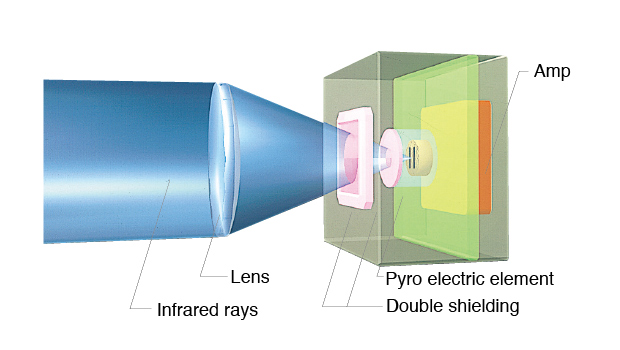
- What is Digital Anti-masking Technology?
-
Digital processing circuit guarantees reliability in a practical way by adapting to any changes detected in the environment.

- What is Advanced Sealed Optics?
-
The pyroelectric element’s field of view is fully enclosed by the sealed optics mechanism of the lens, cover and the sealed optics foam. This mechanism prevents insects from crossing in front of the pyroelectric element. The sealed optics also protect against draft through wiring holes. Easy knockouts reduce extra space between holes and cables, further enhancing the sealing of the entire housing.
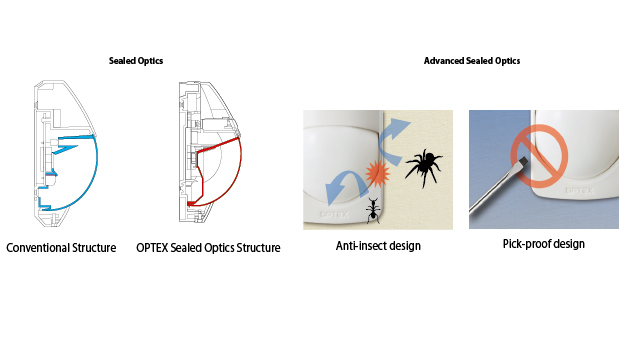
- What is Microwave Area Shaping Technology?
-
When microwave and PIR detection are used together, the detection areas of each must be the same in order to make accurate detection. But traditionally this can be a problem because....
• Firstly, microwaves are not always limited by objects such as wall, windows and partitions, whereas PIR detection is.
• Secondly, the distances at which microwaves can detect movement tend to be far greater than those required by internal intruder detection applications.
Microwave Area Shaping Technology overcomes these problems by matching the microwave detection area to that of the PIR and by limiting it to the room being covered. Long or short distance can be set roughly, by selecting the range using the switch and more precise adjustment is obtained. By doing this, false alarms from beyond the required coverage area or outside the room in question are avoided.
Since the detection area has uniform sensitivity, which minimizes false activation's caused by spot movement in the detection area e.g. small animals.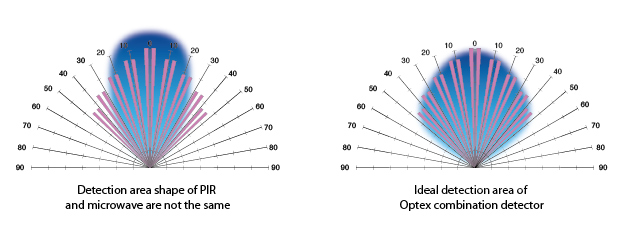
Contact phone number
- Headquarters
- +81-77-579-8004
Contact form
